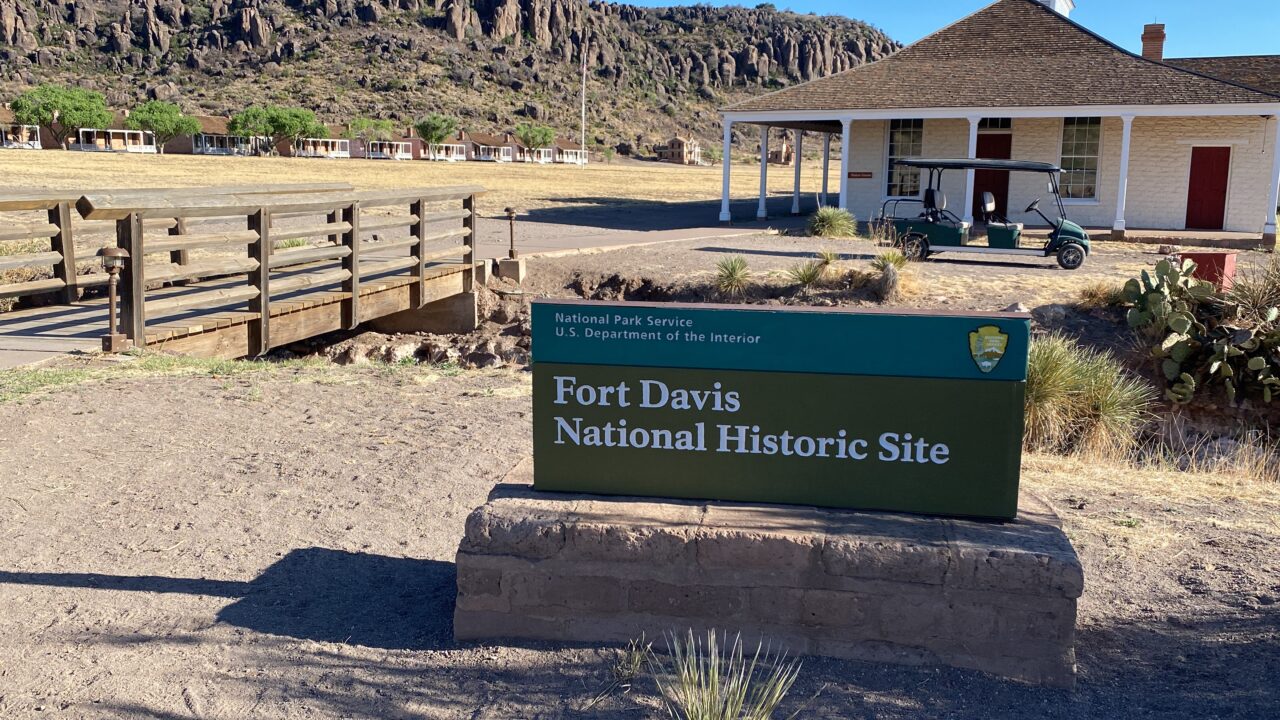Get more Southwest News & Travel Tips Here
Get more Fort Davis National Historic Site Travel Tips & News here!
Where is Fort Davis National Historic Site located?
Fort Davis National Historic Site is located in the small town of Fort Davis, Texas, which is situated in the western part of the state. Nestled in Jeff Davis County, this charming town is surrounded by the picturesque Davis Mountains, providing a stunning backdrop for outdoor activities and exploration. Fort Davis itself is a historic site that dates back to 1854, initially established to protect travelers and settlers from hostile Native American tribes. The region is known for its clear skies, diverse wildlife, and rich cultural heritage, making it a perfect spot for history buffs and nature lovers alike.
Best Time to Visit Fort Davis National Historic Site
The best time to visit Fort Davis National Historic Site is during the spring and fall months when the weather is mild, and the landscape is particularly vibrant. Spring (March to May) brings blooming wildflowers and pleasant temperatures, while fall (September to November) offers cooler weather and fewer crowds. Summer can be quite hot, with temperatures often exceeding 90°F, which may deter some visitors. Additionally, it is advisable to check for any site closures or scheduled events before your visit, as some areas may be temporarily closed for maintenance or special programs. During the fall, visitors can enjoy local festivals that celebrate the region’s culture and history.
How to get to Fort Davis National Historic Site?
Traveling to Fort Davis National Historic Site is relatively simple, and there are several options for air travel. The nearest regional airport is the Alpine-Casparis Municipal Airport (E38), located approximately 20 miles away. For those flying in from further afield, the Midland International Air and Space Port (MAF) serves as the closest major international airport, about 120 miles from Fort Davis. From either airport, visitors can rent a car or arrange for transportation to reach the historic site. The scenic drive through West Texas offers stunning vistas and an opportunity to experience the unique landscape of the Davis Mountains.
What to do when you arrive:
Upon arrival at Fort Davis National Historic Site, visitors should stop by the Visitor Center, where they can gather maps, brochures, and information about the site’s history. The center features exhibits that provide context about the fort’s role in the West and offers a short film that delves into its historical significance. For accommodations, several hotels and guesthouses are available in Fort Davis, ranging from comfortable motels to charming bed and breakfasts. Many visitors also enjoy camping at nearby state parks for a more immersive experience in nature.
Getting Around Locally
Getting around Fort Davis and the surrounding area is relatively easy, especially if you have a vehicle. The town itself is small, making it convenient to walk or drive to local attractions, restaurants, and shops. For those looking to explore the nearby Davis Mountains State Park, having a car is essential as it provides access to various trails and scenic viewpoints. Bicycling is also a popular option for those wanting to enjoy the fresh air and beautiful landscapes at a leisurely pace.
Top Things to Do and See at Fort Davis National Historic Site:
- The Barracks: Explore the historical barracks that housed soldiers stationed at Fort Davis. These restored buildings provide insight into military life in the 19th century and are a highlight for many visitors.
- The Post Hospital: Visit the former post hospital, which showcases the medical practices of the time and the challenges faced by soldiers and their families. The building has been preserved to reflect its original layout and function.
- The Commanding Officer’s Quarters: This beautifully restored building offers a glimpse into the lives of the fort’s leadership. The quarters are furnished with period-appropriate decor, giving visitors a sense of life on the frontier.
- The Historic Cemetery: Take a reflective walk through the historic cemetery, where many soldiers and their families are laid to rest. The site tells stories of sacrifice and bravery, honoring those who served at the fort.
- Nature Trails: Enjoy the scenic nature trails surrounding the historic site that offer opportunities for hiking, birdwatching, and appreciating the unique flora and fauna of the region.
Suggested Itineraries
For a well-rounded experience, consider the following itinerary for your visit to Fort Davis National Historic Site:
- Day 1: Arrive at Fort Davis in the morning, visit the Visitor Center, and explore the barracks and post hospital. Have lunch in town.
- Day 2: Morning hike on one of the nearby nature trails, followed by a visit to the Commanding Officer’s Quarters and the cemetery. Spend the afternoon at the Davis Mountains State Park.
- Day 3: Take a guided tour of the historic site, enjoy a picnic lunch, and explore the local shops and eateries before heading home.
Permits & Fees
Access to Fort Davis National Historic Site requires an entrance fee, which helps maintain the site’s facilities and programs. As of 2023, the entrance fee is $10 per adult, valid for up to seven days. Children under 16 can enter for free. Consider purchasing an America the Beautiful pass if you plan to visit multiple national parks and historic sites, as it provides access to over 2,000 federal recreation sites.
Nearby Day Trips & Detours
There are several fantastic day trips and detours to consider while visiting Fort Davis:
- Big Bend National Park: A short drive away, this expansive park features stunning landscapes, diverse wildlife, and a variety of outdoor activities such as hiking, rafting, and stargazing.
- Marfa: Famous for its art scene and mysterious Marfa Lights, this small town is approximately 30 miles away and offers unique galleries, shops, and dining experiences.
- Alpine: Just 20 miles from Fort Davis, Alpine is home to the Museum of the Big Bend, local shops, and restaurants, making it a great stop for a day excursion.
Local Culture & History
The local culture surrounding Fort Davis is deeply rooted in its rich history and diverse heritage. The town celebrates its military past and the contributions of various cultures, including Native American tribes, Mexican settlers, and early American pioneers. Visitors can experience local festivals, art exhibits, and community events that highlight this unique blend of cultures. The area’s natural beauty and historical significance make Fort Davis a vibrant destination for anyone interested in exploring the American West.
Packing List & What to Bring to Fort Davis National Historic Site
When planning your visit to Fort Davis National Historic Site, it’s essential to pack wisely to ensure a comfortable and enjoyable experience. Here’s a comprehensive packing list to consider:
- Clothing:
- Lightweight, breathable fabrics for warm weather.
- Layered clothing for cooler evenings.
- Comfortable hiking boots or shoes.
- Hat and sunglasses for sun protection.
- Outdoor Gear:
- Daypack for carrying essentials.
- Reusable water bottle to stay hydrated.
- Binoculars for wildlife viewing.
- Camera to capture the stunning landscapes.
- Health and Safety Items:
- Sunscreen to protect against UV rays.
- First aid kit for minor injuries.
- Insect repellent to ward off bugs.
- Personal medications as needed.
- Food and Snacks:
- Non-perishable snacks for hikes, such as trail mix or granola bars.
- Picnic supplies if you plan to enjoy meals outdoors.
Being prepared with the right gear can enhance your experience and ensure that you enjoy all that Fort Davis National Historic Site has to offer.
Wildlife & Nature Highlights
Fort Davis National Historic Site is not only rich in history but also offers a variety of wildlife and natural beauty. Visitors can observe a range of species and stunning landscapes while exploring the area. Here are some wildlife and nature highlights:
- Birdwatching:The region is home to numerous bird species, including the Mexican jay, canyon wren, and various raptors. Bring binoculars to get a closer look at these fascinating creatures.
- Mammals:Common mammals include mule deer, coyotes, and occasional sightings of foxes. Early morning or late afternoon is the best time to spot these animals as they are more active during cooler hours.
- Flora:The diverse plant life includes desert shrubs, wildflowers, and cacti that bloom beautifully in spring. Take time to appreciate the unique flora that thrives in this arid environment.
- Stargazing:Due to its remote location and minimal light pollution, Fort Davis offers incredible stargazing opportunities. On clear nights, the night sky is filled with stars, making it ideal for astronomy enthusiasts.
Exploring the natural surroundings of Fort Davis can provide a deeper appreciation for the area’s ecosystem and the importance of conservation efforts.
Accessibility Information
Fort Davis National Historic Site strives to be accessible to all visitors. Here are some key points regarding accessibility:
- Visitor Center: The Visitor Center is wheelchair accessible, and staff is available to assist with any inquiries about the site.
- Restrooms: Accessible restrooms are located at the Visitor Center and other key areas within the historic site.
- Trails: While some trails may be challenging, there are designated accessible paths that allow visitors with mobility aids to enjoy the scenery.
- Assistance Animals: Service animals are permitted in all areas where visitors are allowed. Visitors with disabilities are encouraged to inquire about specific accommodations as needed.
It’s advisable to contact the site ahead of your visit to discuss specific accessibility needs and to ensure a comfortable experience.
Fort Davis FAQs
Here are some frequently asked questions that may help enhance your visit to Fort Davis National Historic Site:
- Is there an entrance fee?Yes, the entrance fee is $10 per adult, valid for seven days. Children under 16 enter for free.
- Are pets allowed at Fort Davis National Historic Site?Pets are not permitted in the historic site except for service animals. However, pets are allowed in the surrounding areas.
- What are the operating hours?The site is open daily from 9 AM to 5 PM, but hours may vary during holidays, so checking in advance is recommended.
- Are guided tours available?Yes, guided tours are offered at specific times. Check the Visitor Center schedule for tour availability during your visit.
These FAQs can help clarify any uncertainties and contribute to a smoother visit experience.
Additional Resources
For more information and resources related to your visit to Fort Davis National Historic Site, consider the following links:
- National Park Service – Fort Davis National Historic Site
- National Park Service – Health and Safety
- National Park Service – FAQs
- National Park Adventurers on Facebook
Utilizing these resources can further enrich your understanding and enjoyment of Fort Davis National Historic Site, ensuring that you have an unforgettable experience in this beautiful area of Texas.
Follow us on social media for more!

